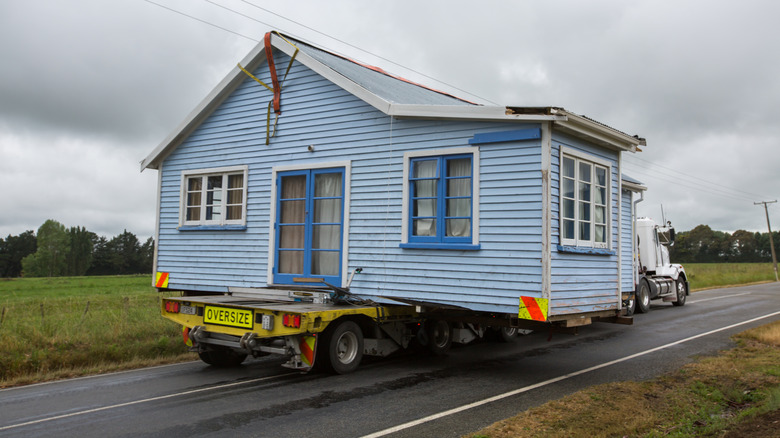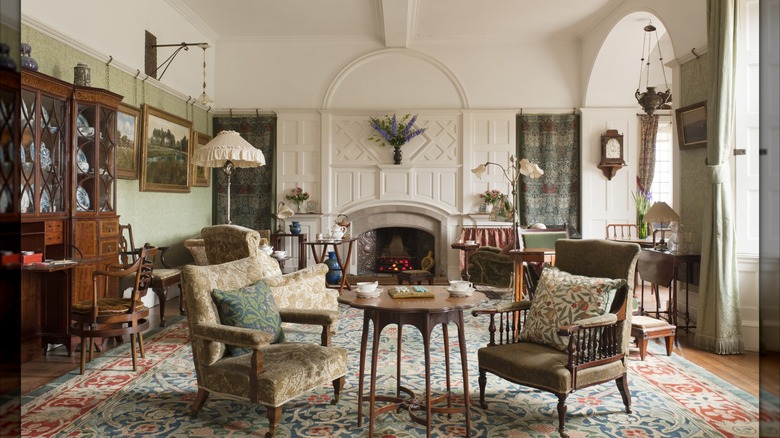What To Know Before Saving A Historic Home Like Jenny And Dave Marrs
When HGTV's "Fixer To Fabulous" stars Dave and Jenny Marrs learned that a 100 year old farmhouse in their historic town was going to be demolished, they decided to move the entire structure to a small plot of land they'd purchased years earlier. Jenny Mars described the complex process on her blog, saying that preparing the move took a month, while the actual move took mere hours. Historic homes are making a comeback today, thanks to their architectural features, unique character, and nostalgic charm. But what exactly goes into saving a historic home when it has to be relocated? To find out, House Digest spoke with design historian Sarah Bilotta in an exclusive interview to learn more about the process, cost, and potential complications.
According to Bilotta, "Historic homes and buildings are moved all the time (and have been throughout history), but this is not usually done by the average homebuyer." She explained that it's much more common for historic homes to be moved as part of a preservation effort by a trust or nonprofit. "Moving an entire house is not impossible, but it's especially tricky when it comes to historic houses, which may be large and have a lot of complex features to keep intact, like ornate windows or complex brickwork," Bilotta shared. The design historian said the feasibility and cost should be determined on a case-by-case basis, taking into consideration how structurally sound the home is, how well it has been maintained, and the overall size.
Moving a historic house is expensive
Before making the investment yourself, it's important to carefully consider the pros and cons of buying a historic house. Both the process and cost to move and restore a historic home might surprise you. "Typically, historic homes are moved to a safe place rather than being torn down (as in the Marrs's case)," Sarah Bilotta said during her exclusive interview with House Digest. "If you hear of a historic home that is about to be torn down in your community, get in touch with the owner (you can find this out through property records or the city hall) to find out if they would let you remove the building and relocate it," she added.
When Dave and Jenny Marrs moved their historic home, they quickly found out that local restrictions prohibited moving a house from one spot within the city limits to another. "How did they ever come up with such a law?," Jenny Marrs mused on her blog. Still, it forced the Marrs' to move the home to land outside the city limits. "Often, if a building is a burden to someone who wants to build anew, they'll be more than happy to see it go," Bilotta said. "However, you must have the budget for the move, which will likely be in the tens of thousands of dollars." The design historian went on to caution that you should budget at least 50% over what you think the complete restoration will cost.
Tell the story of a historic home using period furnishings
After Dave and Jenny Marrs finished moving their historic home, they had to entirely gut the inside before starting an extensive rehabilitation project. The couple was so pleased with the outcome that they decided to make it their family home. But should you purchase and move a historic home of your own? Or is it more practical to just add historical touches to your space some other way?
If you've fallen in love with a historic home, it's important to arm yourself with knowledge before making any decisions. "Do research on the home," Sarah Bilotta advised during her exclusive interview with House Digest. "Your town hall or historical society can likely help you find old photographs of your house," Bilotta said. "This will help you tell the story of your historic home and give you ideas for perhaps conserving some of the original features," she added.
"I am a bit biased, being a historian, but I will always vote for saving an old home over building a new one," Bilotta admitted. "However, that is just not feasible for some people." Recognizing that the moving costs and upkeep for an older home will be higher than building a new one, the design historian offered several suggestions for adding historic touches to a modern home. "Add period moldings, wallpapers, and furnishings for your own Victorian sitting room, or style your front door with a fashionable pedimented door case a la Bridgerton," she offered. "You don't have to stick with one period either — it's okay to go eclectic!"


